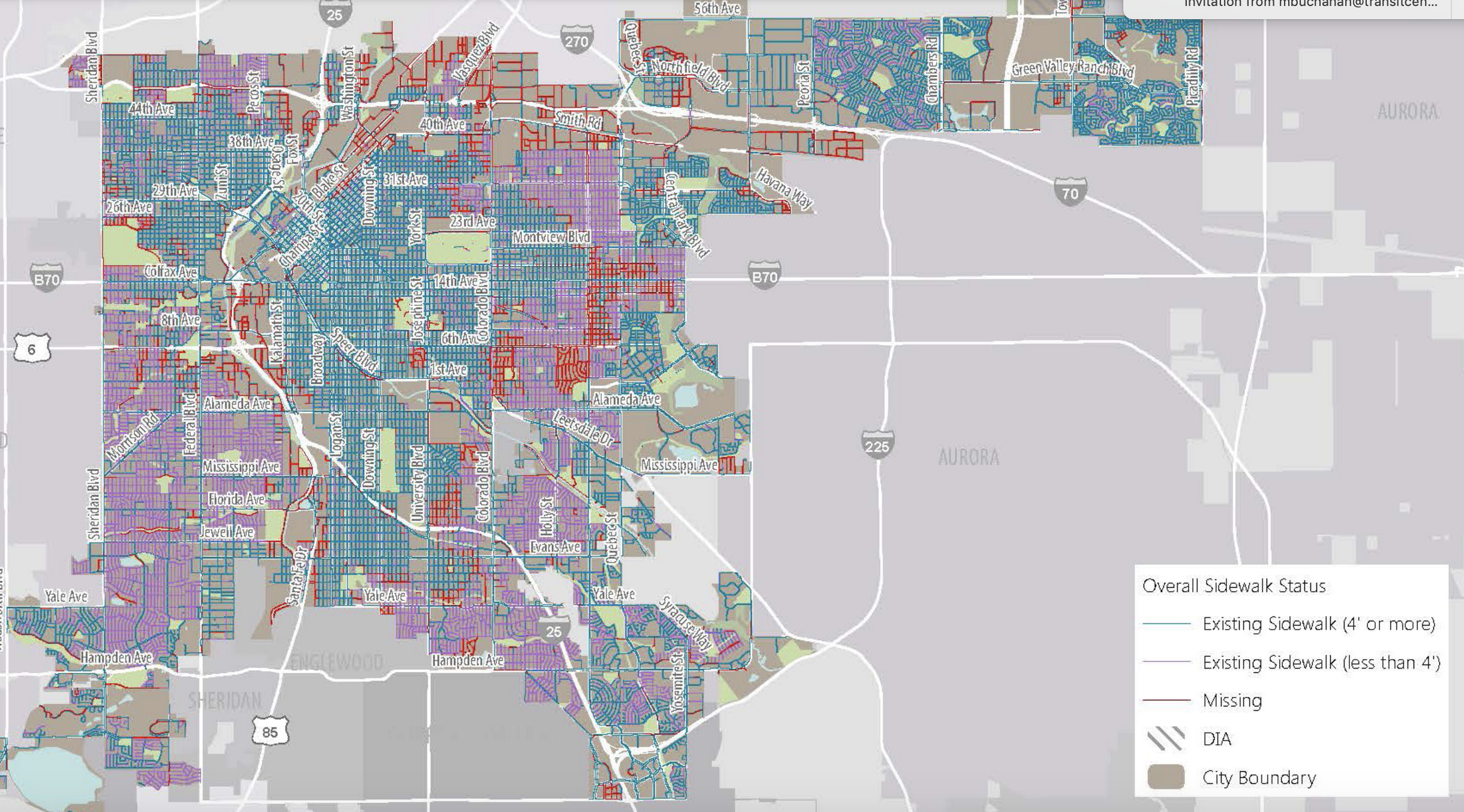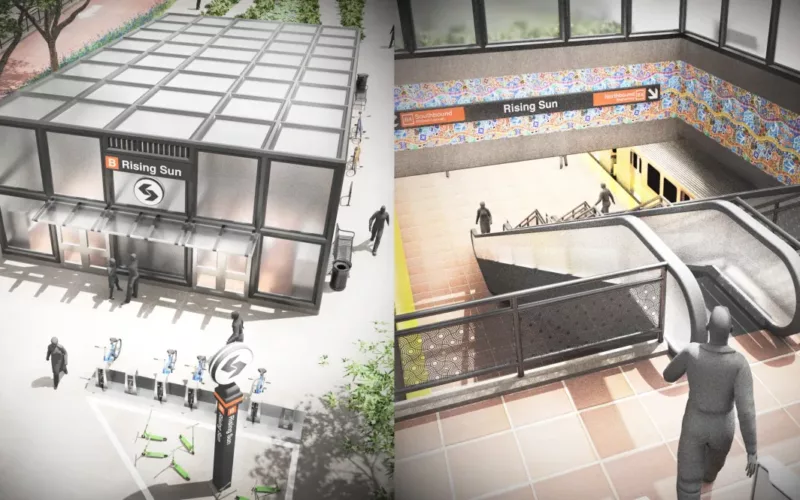
The sidewalk quality assessment conducted for Denver Moves is a model for filling in gaps in data on ADA access and pedestrian infrastructure.
In June, the United States Department of Transportation asked for input from the public about how to assess transportation equity. TransitCenter joined hundreds of civic groups, transportation agencies, and members of the public in responding.
The status quo needs reform. While there are policies in place intended to prevent discrimination in transportation policy, in practice federal mandates are toothless, and the required analyses shed little light on the problem of inequitable access to good transit.
In response, transit agencies, advocates, and researchers have developed new measures that go above and beyond federal requirements. USDOT should support, advance, and popularize these methods.
Below, we summarize our three main points. Our full submission to USDOT can be read here.
Move toward a system-wide standard for transportation equity
The Federal Transit Administration currently requires (through its application of the Title VI of the Civil Rights Act of 1964) that before transit agencies enact a “major” change to their fares or service, they conduct an analysis to show that the change does not have a “disparate impact” on people of color. But these requirements are narrowly defined and too weak to secure equitable transit.
The Title VI analyses examine discrete changes instead of the system as a whole. They aim to determine whether a proposed change avoids disparate impact, but say nothing about the extent to which existing transit service is equitable.
The FTA has commissioned research that recommends more comprehensive measures; it is time to publish that work and, in collaboration with a wide range of stakeholders, replace the current interpretation of Title VI when it comes to public transit service and fare changes. Today’s narrow analyses measuring the impact of proposed changes should be supplemented with a prospective standard that measures the equity of a region’s existing transit network and whether that network offers more equitable access over time.
Ground the analysis in access-to-opportunity metrics
Many equity measures (including some required by Title VI) focus on “who lives near transit,” but this can be quite different from “who benefits from transit.”
To capture the latter question, people in the transit field are increasingly using access-to-opportunity metrics, which quantify the potential destinations someone can reach, or the time to travel to specific types of destinations. These metrics capture important aspects of how people can — or can’t — use transportation systems in their day-to-day lives.
TransitCenter’s recently released Transit Equity Dashboard demonstrates how these measures can help us understand equitable transit access — comparing how effectively the transit network connects people of different races, ethnicities, income status, and other demographics to jobs, education, healthcare, food, and parks. Most of these measures can be replicated by any agency that has a high-quality General Transit Feed Specification (GTFS) and the capacity to analyze Census data.
Additional data would provide additional insight
Several other types of data would allow agencies to more comprehensively measure equitable access. Important needs include:
Fare-constrained access to opportunities. Many metro regions have a “two-tiered” transit system made up of expensive, rapid regional transit and comparatively affordable but slow local transit service. In these regions, many people with low incomes are “priced out” of parts of the transit network, and don’t have as much access as more affluent riders.
The Equity Dashboard calculates these impacts. In the Philadelphia Metropolitan Statistical Area, for example, the average Latinx resident of the can access 145,979 potential jobs in 45 minutes using transit, but only 81% as many jobs using transit that costs less than $4 for a one-way trip.
However, calculating these measures is manually intensive, requiring months of “scraping” fare information from transit agency websites and other sources. If GTFS were improved to better incorporate fares, agencies would face less of a burden in compiling the necessary data.
Transit ADA compliance and pedestrian conditions. Most transportation equity measures do not account for ADA compliance. This is partly due to missing data. Many municipal and regional governments lack complete information about where sidewalks, crosswalks, and curb cuts exist.
One municipal effort worth replicating is the “Denver Moves” planning process. The City of Denver combined data from city maintenance crews, the Denver Regional Council of Governments, and aerial photographs to conclude that 60% of street-miles had sidewalks that met the minimum width (4 feet) required by the ADA, while 30% had sidewalks of insufficient width, and 10% were missing sidewalks. Austin, Texas, recently completed a similar inventory.
On the transit data side, GTFS allows transit agencies to specify whether a transit stop allows people using wheelchairs to board, but few agencies report this data consistently. Other required data include the ADA status of transit vehicles and transit station elevator status.
Qualitative outreach data. Transit agencies regularly conduct public outreach in the course of developing service changes, capital projects, long-range plans, and other initiatives. Typically, this qualitative data is collected for and applied to just one project or initiative.
There are risks when agencies duplicate public engagement efforts in the same community. For example, an agency might conduct public meetings in a neighborhood as part of a long-range planning process, then again for a corridor study, and then a third time in advance of a capital project. This approach is costly–and if people are repeatedly asked the same questions without seeing results from previous outreach, it can decrease public trust in the agency.
Transit agencies should develop cross-team practices to retain and reapply qualitative data from prior outreach that is relevant to any team’s ongoing work–and the federal government should use its grantmaking and research funding to support efforts to do so.
Transportation governance data. Transit agency boards have substantial authority, so improving the practices, and in some cases changing the structure, of transit agencies’ governing boards is an important step to improving transit service.
Forthcoming analysis from TransitCenter shows a pattern of disparities between who sits on transit agency boards and who uses transit. “Who decides” and “who rides” are often very different. For example, fewer than 25 percent of board members of the Southeastern Pennsylvania Transportation Authority are people of color, even though more than 25% of people in the jurisdictions that SEPTA serves, and over 50% of riders, are not white.
The full TransitCenter comment to USDOT is available here. USDOT has said it will publish a summary of comments in September, and will use them to inform an agency “equity plan” and “strategic plan” in February 2022.
 On the Brink: Will WMATA’s Progress Be Erased by 2024?
On the Brink: Will WMATA’s Progress Be Erased by 2024?
The experience of being a WMATA rider has substantially improved over the last 18 months, thanks to changes the agency has made like adding off-peak service and simplifying fares. Things are about to get even better with the launch of all-door boarding later this fall, overnight bus service on some lines starting in December, and an ambitious plan to redesign the Metrobus network. But all of this could go away by July 1, 2024.
Read More To Achieve Justice and Climate Outcomes, Fund These Transit Capital Projects
To Achieve Justice and Climate Outcomes, Fund These Transit Capital Projects
Transit advocates, organizers, and riders are calling on local and state agencies along with the USDOT to advance projects designed to improve the mobility of Black and Brown individuals at a time when there is unprecedented funding and an equitable framework to transform transportation infrastructure, support the climate, and right historic injustices.
Read More